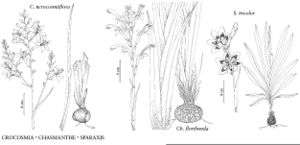Difference between revisions of "Chasmanthe floribunda"
Trans. Roy. Soc. South Africa 20: 274. 1932.
FNA>Volume Importer |
FNA>Volume Importer |
(No difference)
| |
Revision as of 19:33, 24 September 2019
Plants 60–120 cm; corm depressed-globose, 40–70 mm diam. Stems 1–2-branched. Leaves 8–10, mostly basal, basal longer than cauline; blade lanceolate, ± reaching base of spike, 18–35 mm wide. Spikes 25–40-flowered; outer spathe 13–15 mm, apex obtuse to truncate; inner ± equaling outer, apex bifurcate; flowers distichous. Tepals: perianth tube 35–45 mm, 9–12 mm proximally, often twisted, ca. 40 mm distally, base pouched; dorsal tepal horizontal, 28–33 × 7–9 mm, much exceeding others; lateral tepals patent or recurved, 12–15 × 4–7 mm; lower median tepal slightly smaller than laterals; filaments 50–55 mm; anthers 7–8 mm; ovary 6–9 mm, style branching shortly below and opposite to anthers (or exceeding them); branches 7–10 mm. Capsules 10–15 mm. Seeds 5–7 mm diam.
Phenology: Flowering mostly Feb–May.
Habitat: Road verges, grassy slopes
Elevation: 0–100 m
Distribution
Calif., South Africa.
Discussion
Chasmanthe floribunda has escaped from gardens and has become naturalized locally. It is native to the winter-rainfall region of South Africa. The species has been confused in North America with C. aethiopica (Linnaeus) N. E. Brown, which has similar flowers but is a smaller plant with unbranched stems, normally flowering in the early winter months.
Selected References
None.
